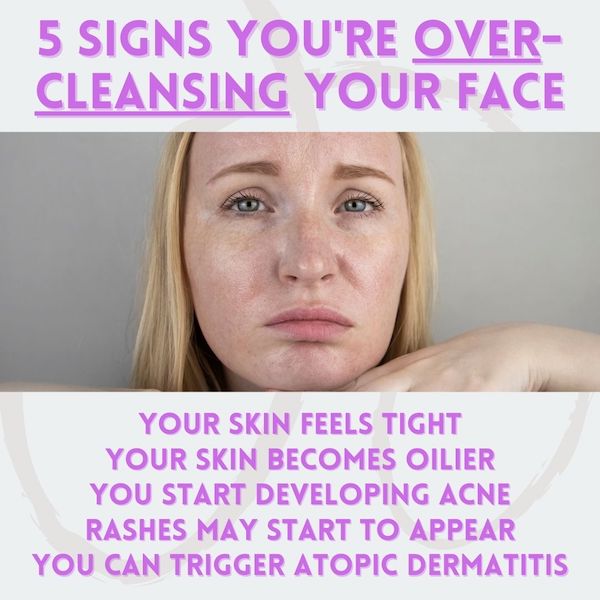Cleansing your face is arguably the most important step of your skincare routine.
Your skin acts as a natural barrier and its sole “job” is to keep dirt, bacteria, and environmental pollution out and protect your organs from infections, thus it is quite important to keep it clean so it can protect you from harmful pathogens.
But, I have seen some people that have overly complicated double, or triple-cleansing routines, which as much as you may believe is good, might not always be the case.
Is it possible to over-cleanse / over-wash your face?
Yes, it is. In this article, I am going to tell you about the 5 signs & symptoms you need to look out for to see if you’re over-cleansing, as well as how to repair the damage from over-cleansing.

What Happens If You Over-Cleanse Your Face?
As with any other skincare product, striking the right balance is what usually works, but this is not an easy thing to achieve, and I am sure many of you will agree.
Cleansing, as I said earlier, is an essential step in your skincare routine. But it is also the step we tend to mess up the most.
Let’s work at some of the signs that clearly show your skin may be getting a bit too much of unnecessary daily cleansing.
Signs You Are Over-Cleansing Your Face

Tightness and Discomfort
One of the most common misconceptions in cleansing your face is that your skin should feel squeaky-clean and tight after cleansing it.
Especially if you are someone that deals with oily skin, you probably feel like your face isn’t even clean unless you have a tight, dry feeling and the grease is finally gone.
But it is certainly not gone for good and I am sure you can confirm this too. Besides that, is this really how your skin should feel all the time? Absolutely not.
Having that cleansed-to-perfection kind of feeling after washing your face means you have stripped your skin of its natural lipid barrier and altered its healthy pH level.
Or in simple terms – your skin is not able to protect itself from harmful pathogens when it’s in this condition.
Two words perfectly describe the condition of your skin after cleansing too often or using a harsh cleanser. These are raw and dehydrated.
Unfortunately, your skin isn’t cleansed properly, but it is being left raw, dehydrated, and vulnerable.
Which very conveniently leads us to the next one.
Excess Skin Oil
That’s right. Your way to describe this is that your skin becomes oilier the more you try to keep it clean. MY way to describe this is that your skin has become sensitized.
And this can happen for two reasons:
- You are over-cleansing your skin
- You are using harsh/alkaline (drying) products to cleanse your skin
Either-or or maybe even both of them together can make your skin become sensitized and this will result in overproduction of sebum.
How does this happen?
Well, think of it this way. When you are over-cleansing your skin and stripping away the natural moisture that’s on the surface, your skin will start to feel a little…attacked.
So it will react to this attack by obviously defending itself and producing more sebum in order to replenish the loss of moisture.
Imagine having that shine on your forehead, but when you look closely your skin looks fragile, like it’s about to crack open. That is pretty much how oily-dehydrated skin looks.
It is oily underneath and you can clearly see the oil, but you can also clearly see the dehydration, you just have to learn how to recognize it.
Wanna know what happens once your sebaceous glands are triggered into overproduction of sebum?
Acne
The main concern with the overproduction of sebum is that it can clog your pores and clogged pores are the main reason behind acne breakouts.
Interestingly enough, your skin is home to bacteria that live off the fatty acids present in your sebum and play a role in maintaining the healthy balance of your skin.
However, this bacteria can turn very nasty very quickly and start causing problems on your skin when it’s triggered.
It can enter your pores ,and due to the airless environment ,an overproduction of sebum creates, it can trigger an inflammatory response in the form of acne breakouts.
So, if you are breaking out randomly and can’t figure out what’s triggering your outbreaks, you shouldn’t exclude the possibility that your cleansing habits could very well be the culprit.
Rashes
Your natural skin barrier may become compromised due to over-cleansing and therefore unable to protect you from irritations, inflammatory responses, and pathogenic bacteria.
A damaged skin barrier can very easily become susceptible to infections that can lead to painful rashes and even sores due to harmful environmental irritants.
Atopic Dermatitis
Environmental irritants and allergens such as soaps, shampoos, and cleaning products are known to aggravate symptoms of eczema.
However, these may even trigger the appearance of eczema due to the highly alkaline ingredients they contain.
If you tend to over-cleanse with a harsh cleanser that leaves your skin feeling tight and stripped, eliminating this product and reducing the amount of cleansing your skin in a day may relieve your eczema symptoms.
How To Repair Skin Damage From Over-Cleansing?

If you have experienced some of the uncomfortable symptoms listed above and you are confident you can blame them on your cleansing habits or using harsh products…
Now would be a good time to start repairing the damage you have done to your skin.
Here are some of the things you may find useful in replenishing the lost moisture and rehydrating your skin back to life:
1. Ditch Your Harsh Cleanser
Having greasy skin isn’t an excuse for using harsh cleansers because the problem is probably somewhere else.
Essentially you would inevitably do your skin a favor by ditching the product you may suspect is causing excessive dryness or oiliness.
The best solution is to always go with a mild and gentle cleanser. And this doesn’t mean that a cleanser is gentle just because it says so on the bottle.
Luckily, you will find the ingredients list at the back of the bottle so opt for the following repairing ingredients:
- Surfactants – they are the basis for many face cleansers because they remove dirt, oil, and debris from the skin. Different surfactants are combined in cleansers to minimize the irritating potential of the cleansers that are meant to effectively remove traces of pollution on your skin. A good surfactant is Sodium Laureth Sulfate which is NOT the same as Sodium Lauryl Sulfate that can actually be mean to your skin. Make sure to remember the difference next time you are purchasing a cleanser.
- Emollients – they are a key ingredient to a nourishing cleanser and if you are noticing that yours may be a bit too drying this is probably because it is lacking emollients as a key ingredient. Emollients help to reduce the amount of moisture loss from your skin. Examples of emollient ingredients include petrolatum, lanolin, and ceramides.
- Humectants – they work in a similar manner to emollients and help your skin to retain moisture. The most common humectant added in face cleansers is glycerin. Glycerin is popular because it is found to be a skin-identical ingredient because it can naturally be found in the skin.
2. Reduce the amount of cleansing your face daily.
If you are tending to cleanse your face up to three times a day in an attempt to get rid of the oil that constantly keeps popping up, a very useful tip would be to reduce the amounts of cleansing.
There is no such thing as “I have the greasiest skin”. This can only mean that there is probably something you are doing and it’s triggering the overproduction of oil.
Cleansing in the evening is always a must because going to bed with all the daily grime and pollution on your face and depositing it on your pillow is not a good idea.
However, morning cleanse can sometimes be skipped, and there’s no need for guilty conscience too when you can just get away with swiping a toner across your face and slathering on sunscreen.
3. Hydrating serums should become your new best friends.
One example of an extremely hydrating ingredient is Hyaluronic acid and it is often found in serums due to its ability to be absorbed quickly by the skin.
It is a natural compound that is found in your body and has the ability to attract and retain more than 1,000 times its own weight in water.
Hyaluronic acid draws moisturize from the atmosphere and into the skin which makes it great for that boost of hydration your raw skin may be needing.
4. Don’t forget to seal it all in with a moisturizer.
I see many people making the terrible mistake of skipping on applying a moisturizer daily due to various reasons. I get it, it’s greasy and this is the last thing you need if your skin is already on the oily side.
But everyone, even oily skins need hydration. Especially if it has been damaged by using harsh products and over-cleansing.
Incorporating a light, hydrating moisturizer into your skincare routine will seal the moisture into your skin and prevent it from evaporating.
It will also strengthen the natural barrier of your skin and before you know it you will start seeing the results of recovery.

My name is Simone and I am a certified skin specialist. I created this website to teach my readers how to take great care of their skin and I also like to occasionally share my honest opinions on skincare products I’ve tried. You can learn more about me here.
